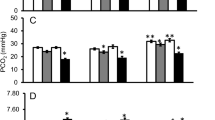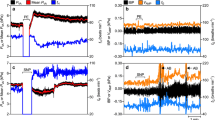Abstract
Reptilian embryos naturally experience fluctuating oxygen levels in ovo, and developmental hypoxia has been established to have long-term impacts on cardiovascular function in vertebrates. In the present study, we investigated the impact of developmental 21% (normoxia) and 10% O2 (hypoxia) on juvenile (4-year-old) American alligator cardiovascular function in animals at rest and during swimming. In both experimental groups, combined right aortic and right subclavian blood flow approximately doubled during swimming. Carotid blood flow increased during swimming in the hypoxia-programmed animals only, and both carotid and left aortic blood flow reached higher values in swimming hypoxic-programmed animals compared to the normoxic group. However, pulmonary blood flow, which increased two to threefold during swimming (in both groups), was higher in normoxic-programmed animals at both rest and swimming. The differences between programming groups were preserved after cholinergic blockade (atropine), but reduced by adrenergic receptor antagonists (propranolol and phentolamine). Propranolol and phentolamine also blunted the incremental increases in blood flows during swimming, which was especially clear in the hypoxia-programmed animals. Alteration in adrenergic control and relative cardiac size (which was increased in hypoxic-programmed alligators) may account for the differences between the experimental groups.




Similar content being viewed by others
References
Altimiras J, Aissaoui A, Tort L, Axelsson M (1997) Cholinergic and adrenergic tones in the control of heart rate in teleosts. How should they be calculated? Comp Biochem Physiol Part A Physiol 118:131–139
Anderson SN, Podrabsky JE (2014) The effects of hypoxia and temperature on metabolic aspects of embryonic development in the annual killifish Austrofundulus limnaeus. J Comp Physiol B 184:355–370
Axelsson M, Franklin C (1997) From anatomy to angioscopy: 164 years of crocodilian cardiovascular research, recent advances, and speculations. Comp Biochem Physiol A Comp Physiol 118:51–62. https://doi.org/10.1016/S0300-9629(96)00255-1
Axelsson M, Holm S, Nilsson S (1987) Flow dynamics of the crocodilian heart. AJP Regul Integr Comp Physiol 256:R875–R879
Barker DJP (2000) In utero programming of cardiovascular disease. Theriogenology 53:555–574
Bateson P, Gluckman P, Hanson M (2014) The biology of developmental plasticity and the predictive adaptive response hypothesis. J Physiol 592(11):2357–2368. https://doi.org/10.1113/jphysiol.2014.271460
Berner RA, Vanden Brooks JM, Ward PD (2007) Oxygen and evolution. Science 316:557–558
Braga VHDS, Armelin VA, Teixeira MT, Abe AS, Rantin FT, Florindo LH (2016) The effects of feeding on cardiac control of the broad-nosed caiman (Caiman latirostris): the role of the autonomic nervous system and NANC factors. J Exp Zool A Ecol Genet Physiol 325:524–531
Burggren WW, Reyna KS (2011) Developmental trajectories, critical windows and phenotypic alteration during cardio-respiratory development. Respir Physiol Neurobiol 178:13–21
Coote JH (2013) Myths and realities of the cardiac vagus. J Physiol 591:4073–4085
Crossley DA, Altimiras J (2005) Cardiovascular development in embryos of the American alligator Alligator mississippiensis: effects of chronic and acute hypoxia. J Exp Biol 208:31–39
Crossley DAII, Burggren WW, Altimiras J (2003) Cardiovascular regulation during hypoxia in embryos of the domestic chicken Gallus gallus. Am J Physiol Regul Integr Comp Physiol 284:R219–R226
Davis LE, Hohimer AR, Morton MJ (1999) Myocardial blood flow and coronary reserve in chronically anemic fetal lambs. Am J Physiol 277(46):R306–R313
Davis L, Thornburg KL, Giraud GD (2005) The effects of anaemia as a programming agent in the fetal heart. J Physiol 565(1):35–41
Eme J, Altimiras J, Hicks JW, Crossley DAII (2011) Hypoxic alligator embryos: chronic hypoxia, catecholamine levels and autonomic responses of in ovo alligators. Comp Biochem Physiol A Mol Integr Physiol 160:412–420
Eme J, Rhen T, Tate KB, Gruchalla K, Kohl ZF, Slay CE, Dane A, Crossley II (2013) Plasticity of cardiovascular function in snapping turtle embryos (Chelydra serpentina): chronic hypoxia alters autonomic regulation and gene expression. Am J Physiol Regul Integr Comp Physiol 304:R966–R979
Filogonio R, Alcantara Costa Leite C, Wang T (2017) Vascular distensibilities have minor effects on intracardiac shunt patterns in reptiles. Zoology 122:46–51
Forsman A (2015) Rethinking phenotypic plasticity and its consequences for individuals, populations and species. Heredity 115(4 115):276–284
Franklin C, Axelsson M (1994) The intrinsic properties of an in situ perfused crocodile heart. J Exp Biol 186:269–288
Galli G, Taylor EW, Wang T (2004) The cardiovascular responses of the freshwater turtle Trachemys scripta to warming and cooling. J Exp Biol 207:1471–1478
Galli GLJ, Crossley J, Elsey RM, Dzialowski EM, Shiels HA, Crossley DA (2016) Developmental plasticity of mitochondrial function in American alligators, Alligator mississippiensis. Am J Physiol Regul Integr Comp Physiol 311:R1164–R1172
Garland T Jr, Cadney MD, Waterland RA (2016) Early-life effects on adult physical activity: concepts, relevance, and experimental approaches. Physiol Biochem Zool 90:1–14
Garland T, Kelly SA (2006) Phenotypic plasticity and experimental evolution. J Exp Biol 209:2344–2361
Herrera EA, Salinas CE, Blanco CE, Villena M, Giussani DA (2013) High altitude hypoxia and blood pressure dysregulation in adult chickens. J Dev Orig Health Dis 4(01):69–76. https://doi.org/10.1017/S204017441200058X
Horváthová T, Antoł A, Czarnoleski M, Kozłowski J, Bauchinger U (2017) An evolutionary solution of terrestrial isopods to cope with low atmospheric oxygen levels. J Exp Biol 220:1563–1567
Hutter D, Kingdom J, Jaeggi E (2010) Causes and mechanisms of intrauterine hypoxia and its impact on the fetal cardiovascular system: a review. Int J Pediatr 2010:401323–401329. https://doi.org/10.1155/2010/401323
Iversen NK, Dupont-Prinet A, Findorf I, McKenzie DJ, Wang T (2010) Autonomic regulation of the heart during digestion and aerobic swimming in the European sea bass (Dicentrarchus labrax). Comp Biochem Physiol A Mol Integr Physiol 156:463–468
Jones DR, Shelton G (1993) The physiology of the alligator heart: left aortic flow patterns and right-to-left shunts. J Exp Biol 176:247–270
Joyce W, Axelsson M, Wang T (2017) Autoregulation of cardiac output is overcome by adrenergic stimulation in the anaconda heart. J Exp Biol 220:336–340
Joyce W, Elsey R, Wang T, Crossley DA (2018) Maximum heart rate does not limit cardiac output at rest or during exercise in the American alligator (Alligator mississippiensis). Am J Physiol (regulatory, integrative and comparative physiology) (in press)
Kam Y-C (1993) Physiological effects of hypoxia on metabolism and growth of turtle embryos. Respir Physiol 92:127–138
Kelly SA, Panhuis TM, Stoehr AM (2011) Phenotypic plasticity: molecular mechanisms and adaptive significance. Wiley, Hoboken
Lutz PL, Dunbar-Cooper A (1984) The nest environment of the American crocodile (Crocodylus acutus). Copeia 1984:153. https://doi.org/10.2307/1445047
Moczek AP (2015) Developmental plasticity and evolution—quo vadis? Heredity 115(4 115):302–305
Moore FB-G, Hosey M, Bagatto B (2006) Cardiovascular system in larval zebrafish responds to developmental hypoxia in a family specific manner. Front Zool 9(1 3):4
Mueller CA, Eme J, Burggren WW, Roghair RD, Rundle SD (2015) Challenges and opportunities in developmental integrative physiology. Comp Biochem Physiol A Mol Integr Physiol 184:113–124
Mulder ALM, Golde JMCG, Goor AAC, Giussani DA, Blanco CE (2000) Developmental changes in plasma catecholamine concentrations during normoxia and acute hypoxia in the chick embryo. J Physiol 527:593–599
Owerkowicz T, Elsey RM, Hicks JW (2009) Atmospheric oxygen level affects growth trajectory, cardiopulmonary allometry and metabolic rate in the American alligator (Alligator mississippiensis). J Exp Biol 212:1237–1247
Papamatheakis DG, Wilson SM, Blood AB, Kim JH (2013) Antenatal hypoxia and pulmonary vascular function and remodeling. Curr Vasc Pharmacol 11:616–640. https://doi.org/10.2174/1570161111311050006
Rook W, Johnson CD, Coney AM, Marshall JM (2014) Prenatal hypoxia leads to increased muscle sympathetic nerve activity, sympathetic hyperinnervation, premature blunting of neuropeptide Y signaling, and hypertension in adult life. Hypertension 64:1321–1327
Rouwet EV, Tintu AN, Schellings MWM, van Bilsen M, Lutgens E, Hofstra L, Slaaf DW, Ramsay G, le Noble FAC (2002) Hypoxia induces aortic hypertrophic growth, left ventricular dysfunction, and sympathetic hyperinnervation of peripheral arteries in the chick embryo. Circulation 105:2791–2796
Ruijtenbeek K, le Noble FAC, Janssen GMJ, Kessels CGA, Fazzi GE, Blanco CE, De Mey JGR (2000) Chronic hypoxia stimulates periarterial sympathetic nerve development in chicken embryo. Circulation 102:2892–2897
Salinas CE, Blanco CE, Villena M, Giussani DA (2014) High-altitude hypoxia and echocardiographic indices of pulmonary hypertension in male and female chickens at adulthood. Circ J 78:1459–1464
Shelton G, Jones D (1991) The physiology of the alligator heart: the cardiac cycle. J Exp Biol 158:539–564
Silva AS, Zanesco A (2010) Physical exercise, β-adrenergic receptors, and vascular response. J Vasc Bras 9:47–56
Simonetta G, Rourke AK, Owens JA, Robinson JS, Mcmillen IC (1997) Impact of placental restriction on the development of the sympathoadrenal system. Pediatr Res 42:805–811
Skals M, Skovgaard N, Abe AS, Wang T (2005a) Venous regulation in reptiles (abstract). Comp Biochem Physiol Part A 141:S189–S218
Skals M, Skovgaard N, Abe AS, Wang T (2005b) Venous tone and cardiac function in the South American rattlesnake Crotalus durissus: mean circulatory filling pressure during adrenergic stimulation in anaesthetised and fully recovered animals. J Exp Biol 208:3747–3759
Tate KB, Rhen T, Eme J, Kohl ZF, Crossley J, Elsey RM, Crossley II DA (2015) Periods of cardiovascular susceptibility to hypoxia in embryonic american alligators (Alligator mississippiensis). Am J Physiol Regul Integr Comp Physiol. https://doi.org/10.1152/ajpregu.00320
Taylor EW, Leite CAC, Sartori MR, Wang T, Abe AS, Crossley DA (2014) The phylogeny and ontogeny of autonomic control of the heart and cardiorespiratory interactions in vertebrates. J Exp Biol 217:690–703
Wahlqvist I, Campbell G (1988) Autonomic influences on heart rate and blood pressure in the toad, Bufo marinus, at rest and during exercise. J Exp Biol 134:377–396
Wang T, Hicks JW (1996) Cardiorespiratory synchrony in turtles. J Exp Biol 199:1791–1800
Wang T, Taylor EW, Andrade D, Abe AS (2001) Autonomic control of heart rate during forced activity and digestion in the snake Boa constrictor. J Exp Biol 204:3553–3560
Warburton SJ, Hastings D, Wang T (1995) Responses to chronic hypoxia in embryonic alligators. J Exp Zool 273:44–50
Wearing OH, Eme J, Rhen T, Crossley DA (2016) Phenotypic plasticity in the common snapping turtle (Chelydra serpentina): long-term physiological effects of chronic hypoxia during embryonic development. Am J Physiol Regul Integr Comp Physiol 310:R176–R184
Wearing OH, Conner J, Nelson D, Crossley J, Crossley DA (2017) Embryonic hypoxia programmes postprandial cardiovascular function in adult common snapping turtles (Chelydra serpentina). J Exp Biol 220:2589–2597
West-Eberhard MJ (2003) Developmental plasticity and evolution. Oxford University Press, Oxford
White DW, Raven PB (2014) Autonomic neural control of heart rate during dynamic exercise: revisited. J Physiol 592:2491–2500
Acknowledgements
This work was supported by NSF CAREER award IBN IOS-0845741 to D.A.C.II. W.J. and T.W. were supported by an EliteForsk travel grant from the Danish Ministry of Higher Education and Science and The Danish Council for Independent Research/Natural Sciences. We are sincerely grateful to Brandt Smith for assistance during the post-mortem dissections. We also thank Jamie Adenuga for suggestions that aided flow probe maintenance.
Author information
Authors and Affiliations
Corresponding author
Additional information
Communicated by H. V. Carey.
Rights and permissions
About this article
Cite this article
Joyce, W., Miller, T.E., Elsey, R.M. et al. The effects of embryonic hypoxic programming on cardiovascular function and autonomic regulation in the American alligator (Alligator mississippiensis) at rest and during swimming. J Comp Physiol B 188, 967–976 (2018). https://doi.org/10.1007/s00360-018-1181-2
Received:
Revised:
Accepted:
Published:
Issue Date:
DOI: https://doi.org/10.1007/s00360-018-1181-2




